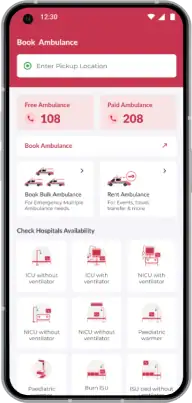Ambulance has a crucial role in providing emergency medical services to patients in need. But before you book an ambulance you must be aware of different types of ambulance in India. So, you can call the right one at the right time and save the life of your near and dear ones. In this blog post, we will explore the various types of ambulances services in India and their significance in delivering timely and appropriate care. Let’s understand how these specialized services contribute to saving lives in India.
Different Types of Ambulances in India
The availability of diverse ambulance options ensures that patients receive the necessary medical attention and transportation based on their condition and location, ultimately contributing to better healthcare outcomes.
Let’s explore the ambulance services one by one.
1. Basic Life Support (BLS) Ambulances:
A Basic Life Support ambulance is the most common type of emergency service and is typically the first responder in these situations. These ambulances come equipped with essential medical devices and trained personnel. So, they can provide basic medical care on the spot. Their main job is to stabilise patients, administer first aid, and ensure a safe transportation environment. BLS ambulances are often dispatched for non-life-threatening emergencies and play a crucial role in initial patient assessment and support.
2. Advanced Life Support (ALS) Ambulances:
Advanced Life Support ambulances are equipped with additional medical equipment and highly trained medical professionals capable of providing life-saving assistance in emergencies. Simply put, they are the advanced version of Basic Life Support ambulances. ALS ambulances can administer medications, perform advanced airway management, monitor vital signs, and provide cardiac life support. So, these ambulance services are typically dispatched for more critical emergencies, where immediate medical intervention is necessary.
3. Air Ambulances:
Air ambulances help in providing rapid transportation for critically ill or injured patients over long distances or in areas with limited accessibility. They can come in the form of helicopters or fixed-wing aircraft and are usually equipped with advanced medical equipment and staffed by specialized medical teams. The biggest advantage of air ambulances is that they reduce travel time to reach medical facilities. So, it makes them invaluable in situations where time is of the essence, such as in remote locations or major accidents with multiple casualties.
Also Read: Is Air ambulance too Costly?
4. Non-Emergency Patient Transport Ambulances:
Non-emergency patient transport ambulances are helpful in transporting stable patients who require medical assistance but do not require immediate emergency care. The advantage of these ambulances is that they free up emergency resources and provide transportation services for patients going to and from medical appointments, rehabilitation centres, or nursing homes. They further ensure the comfort and safety of patients during transportation. It includes factors like seating comfort, accessibility, and medical equipment requirements.
5. Intensive Care Unit (ICU) Ambulance:
ICU ambulances are specially designed emergency services that help in transporting critically ill patients who require intensive medical care. These ambulances come equipped with advanced life support systems, ventilators, cardiac monitors, infusion pumps, and other critical care equipment. During the transportation, highly trained medical personnel, such as critical care nurses and doctors, accompany the patient to provide constant monitoring and specialized care throughout the journey.
6. Boat Ambulance:
Boat ambulances in India provide emergency services in areas where access to medical facilities is limited due to water bodies or remote locations. These ambulances also come equipped with the necessary medical equipment and are staffed with trained medical personnel who can provide medical assistance and transportation via waterways. Boat ambulances play a crucial role in reaching individuals in coastal regions, islands, or areas prone to flooding, ensuring timely medical aid in emergencies.
7. Dead Body Ambulance:
Dead body ambulances are also known as mortuary vans. These ambulances are used for the dignified transportation of deceased individuals. They come with facilities to preserve and transport the body and also ensure compliance with cultural and legal requirements. Dead body ambulances have a vital role in providing a respectful and organized means of transporting the deceased to mortuaries or funeral homes.
8. E-Rickshaw Ambulance:
E-Rickshaw ambulances are compact and agile vehicles that are designed to navigate narrow and crowded urban areas. These e-rickshaws come equipped with basic medical equipment and can quickly reach congested areas or locations inaccessible to larger vehicles. E-Rickshaw ambulances are important in providing prompt medical assistance in densely populated regions, allowing for efficient transportation of patients to nearby medical facilities.
Ambulance Services around the World
In the above sections, we have listed the different types of ambulances in India. But these ambulance services vary from country to country and also in equipment, training, and standards. Some countries have well-developed emergency medical services with advanced ambulance systems, while others may face challenges due to limited resources or infrastructure. But innovations and advancements in ambulance services are continuously evolving. They aim to improve response times, enhance patient care, and bridge the gap between emergency medical services and hospital care.
Future Possibilities in Ambulances
The future of ambulance services looks promising and exciting as technological advancements are being integrated into ambulance designs. These include features such as advanced communication systems, real time patient monitoring, and GPS tracking for efficient dispatching. Telemedicine and remote diagnostics are becoming integral components. This allows paramedics to connect with doctors and specialists in real-time, facilitating remote consultations and guidance.
Conclusion
Ambulances serve as lifelines during emergencies, providing critical medical care and transportation when every second counts. Understanding the different types of ambulances in India and their significance is essential to appreciate the specialised services they offer. From Basic Life Support to Advanced Life Support, ICU ambulances, air ambulances, and boat ambulances, each ambulance service play a vital role in saving lives and ensuring timely access to medical care. As technology continues to advance, we can expect even more innovative solutions to enhance emergency medical services and further improve patient outcomes.
To know more about our ambulance services, visit MedCab official website or download our app from the app store






